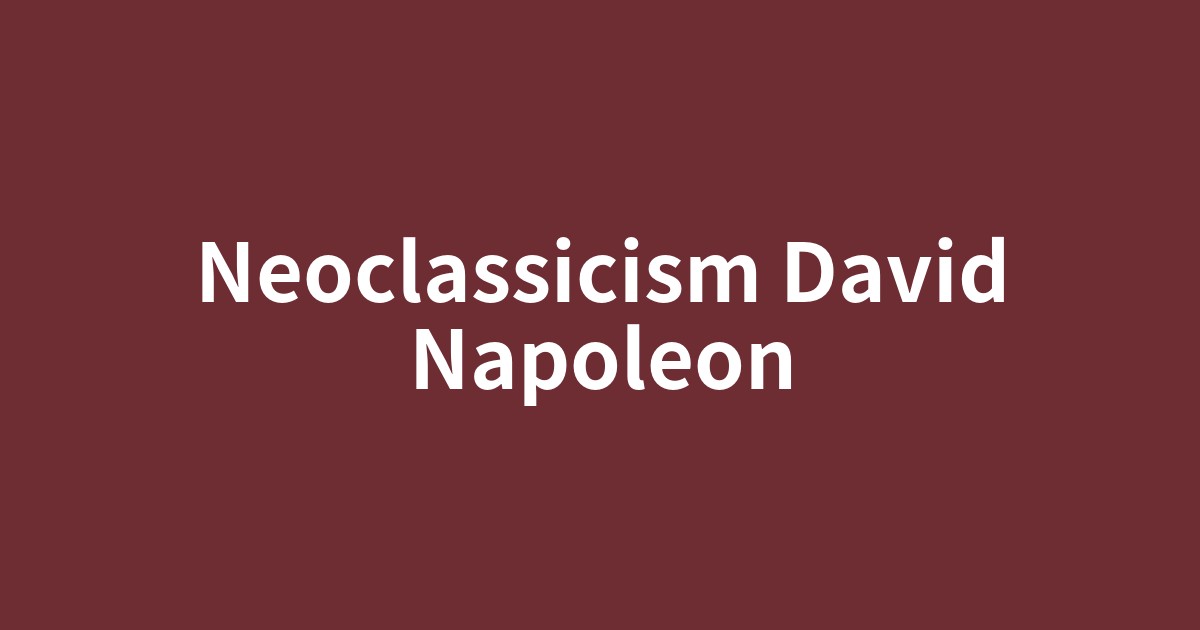このページは、歴史や文化の物語を楽しみながら、その文脈の中で重要な英単語を自然に学ぶための学習コンテンツです。各セクションの下にあるボタンで、いつでも日本語と英語を切り替えることができます。背景知識を日本語で学んだ後、英語の本文を読むことで、より深い理解と語彙力の向上を目指します。

フランス革命の動乱の中、古代ローマの英雄主義を理想とした新古典主義。ダヴィッドが、いかにしてナポレオンのpropaganda(政治宣伝)に貢献したか。
この記事で抑えるべきポイント
- ✓新古典主義が、フランス革命期の社会的な混乱の中で、古代ギリシャ・ローマの秩序や英雄的な道徳観への憧れから生まれた芸術様式であること。
- ✓画家ジャック=ルイ・ダヴィッドが、当初は革命の理想を表現する画家でしたが、後にナポレオン個人の権威を高めるためのプロパガンダ画家へと役割を変えていった経緯。
- ✓《サン=ベルナール峠を越えるナポレオン》などの作品が、単なる記録画ではなく、ナポレオンを歴史上の偉人と並ぶ英雄として神格化するための、意図的な演出(propaganda)に満ちていること。
- ✓芸術が、時には政治権力と密接に結びつき、特定のイデオロギーを広め、権力の正当性を補強するための強力な手段となり得る、という歴史的な一例であること。
英雄は「作られる」のか ― ダヴィッドとナポレオンのプロパガンダ
英雄は生まれつき英雄なのでしょうか。それとも、周到な演出によって「作られる」のでしょうか。馬上で勇ましく嘶く白馬を駆り、兵士たちを鼓舞するナポレオン・ボナパルト。この有名な肖像画を目にしたことがある人は多いでしょう。この記事では、新古典主義という芸術様式を用い、画家ジャック=ルイ・ダヴィッドがナポレオンの英雄イメージをいかにして「創造」したのか、その芸術とプロパガンダ(propaganda)の密接な関係性を探ります。
Are Heroes "Made"? — David and Napoleon's Propaganda
Are heroes born, or are they "made" through careful staging? Many have likely seen the famous portrait of Napoleon Bonaparte, courageously riding a rearing white horse and inspiring his soldiers. In this article, we will explore how the painter Jacques-Louis David "created" Napoleon's heroic image using the Neoclassical art style, and examine the close relationship between art and propaganda.
革命の嵐が求めた「古代の英雄」― 新古典主義の夜明け
18世紀末のフランスは、激動の時代でした。宮廷文化の象徴であった甘美で華やかなロココ美術は色あせ、人々はその軽薄さへの反動から、より厳格で理性的な価値観を求め始めます。その中で勃発したフランス革命(revolution)は、社会に大きな混乱と不安をもたらしました。
The Dawn of Neoclassicism — The "Ancient Heroes" Demanded by the Storm of Revolution
The end of the 18th century was a tumultuous time in France. The sweet and glamorous Rococo art, a symbol of courtly culture, had faded, and in reaction to its perceived frivolity, people began to seek more rigorous and rational values. The French Revolution that erupted amidst this brought great turmoil and anxiety to society.
共和国の理想から皇帝の賛美へ ― ダヴィッドの変節
この新古典主義を代表する画家が、ジャック=ルイ・ダヴィッドです。彼の初期の傑作《ホラティウス兄弟の誓い》は、国家のために命を捧げることを誓う古代ローマの戦士たちを描き、共和政の理想を力強く表現しました。この作品は革命の理念と深く共鳴し、ダヴィッドを時代の寵児へと押し上げます。
From Republican Ideals to Imperial Praise — David's Turn
The leading painter of this Neoclassical movement was Jacques-Louis David. His early masterpiece, *Oath of the Horatii*, depicted ancient Roman warriors vowing to sacrifice their lives for their state, powerfully expressing republican ideals. This work resonated deeply with the principles of the revolution, elevating David to a star of the era.
アルプスを越える英雄の創造 ― 《サン=ベルナール峠を越えるナポレオン》の演出
ダヴィッドがナポレオンのために描いた最も有名な作品が、《サン=ベルナール峠を越えるナポレオン》でしょう。燃えるようなマントを翻し、荒れ狂う馬を見事に乗りこなす姿は、まさに英雄的な(heroic)指導者のイメージそのものです。
The Creation of a Hero Crossing the Alps — The Staging of *Napoleon Crossing the Alps*
The most famous work David painted for Napoleon is likely *Napoleon Crossing the Alps*. The image of him, with a fiery cloak billowing and masterfully controlling a wild horse, is the very picture of a heroic leader.
帝国の栄光を永遠に ― 《ナポレオン一世の戴冠式》という名の神話
クーデターによって権力を掌握し、国民投票を経て皇帝となったナポレオン。彼の権威が頂点に達した瞬間を捉えたのが、壮大な集団肖像画《ナポレオン一世の戴冠式(coronation)》です。
Immortalizing Imperial Glory — The Myth of *The Coronation of Napoleon*
Napoleon seized power through a coup d'état and became emperor after a referendum. The moment his authority reached its zenith is captured in the grand group portrait, *The Coronation of Napoleon*.
芸術と権力、その共犯関係の先に
ジャック=ルイ・ダヴィッドとナポレオンの関係は、芸術が単なる美の探求にとどまらず、政治権力と結びついた時にいかに強力なプロパガンダの道具となり得るかを物語る、歴史的な一例と言えるでしょう。
Beyond the Accomplices of Art and Power
The relationship between Jacques-Louis David and Napoleon is a historical example of how art, when linked with political power, can become a powerful tool of propaganda, going beyond a mere pursuit of beauty.